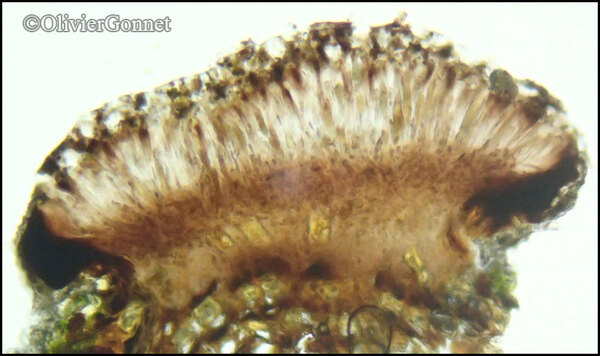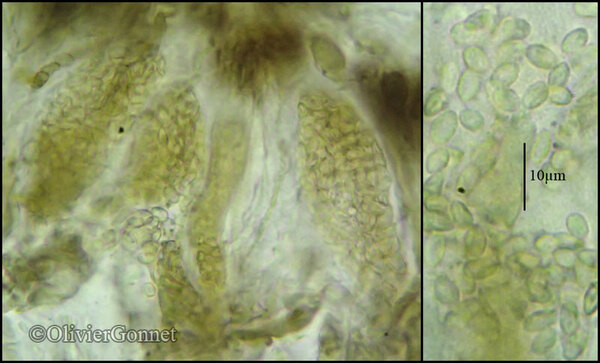Wadeana dendrographa (Nyl.) Coppins & P. James
Lichenologist, 10: 203, 1978. Basionym: Lithographa dendrographa Nyl. - Flora, 47: 488, 1864.
Synonyms:
Distribution: N - Lomb (Gheza & al. 2023). C - Tosc.
Description: Thallus crustose, endosubstratic, usually poorly evident, without a distinct prothallus. Apothecia lirelliform, elongate with attenuate to more rarely rounded ends, 0.5-2.5 x 0.3-0.5 mm, simple or rarely irregularly branched, with a black, exposed disc and a prominent, glossy black, swollen and persistent margin. Proper exciple not extending below the hypothecium, black-brown, 60-85(-100) μm wide, of compacted gelatinized hyphae with red-brown walls; epithecium brown, poorly differentiated from the hymenium; hymenium reddish brown, 100-120 μm high; paraphyses branched, often anastomosing, in a well-defined gelatinous matrix, the apical cells swollen and red-brown; periphysoids branched and rarely anastomosing, slender, somehow moniliform, developing on the inside margin of the exciple; hypothecium pale to red-brown. Asci 100-200-spored, clavate-ellipsoid, evenly thin-walled, slightly thickened at apex, with a K/I+ deep blue cap. Ascospores 1-celled, hyaline, ellipsoid, 5-8 x 3-4 μm. Photobiont trentepohlioid. Spot tests: K-, C-, KC-, P-, UV+ orange-yellow. Chemistry: thallus with an unidentified xanthone.Note: a humid subtropical to Mediterranean-Atlantic lichen, reaching as far north as the British Isles, found on rough, base-rich bark of mature broad-leaved trees (e.g. Fraxinus, Quercus, Ulmus) in semi-natural habitats; perhaps more widespread in Italy, but certainly very rare. It is included as “Critically Endangered” in the Italian red list of epiphytic lichens (Nascimbene & al. 2013c).
Growth form: Crustose
Substrata: bark
Photobiont: Trentepohlia
Reproductive strategy: mainly sexual
Most common in areas with a humid-warm climate (e.g. most of Tyrrenian Italy)
Commonnes-rarity: (info)
Alpine belt: absent
Subalpine belt: absent
Oromediterranean belt: absent
Montane belt: absent
Submediterranean belt: extremely rare
Padanian area: absent
Humid submediterranean belt: extremely rare
Humid mediterranean belt: extremely rare
Dry mediterranean belt: absent
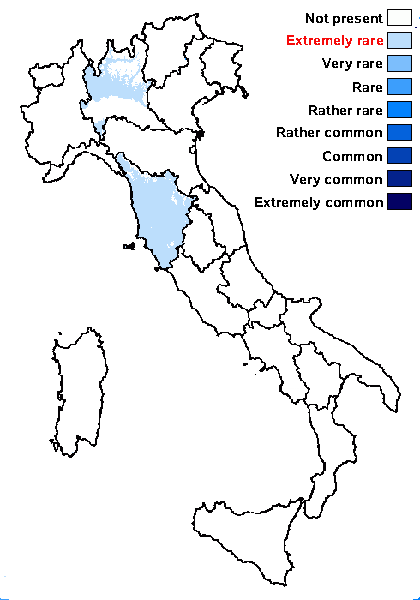
Predictive model
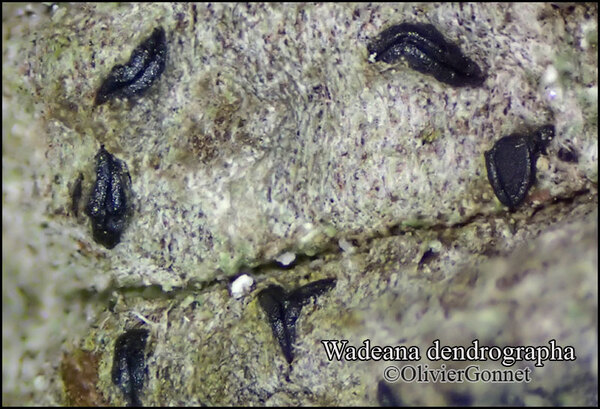
Courtesy Danièle et Olivier Gonnet - Source: https://www.afl-lichenologie.fr/Photos_AFL/Photos_AFL_W/Texte_W1/Wadeana_dendrographa.htm
France, oct. 2015 - sur Quercus ilex - Corse
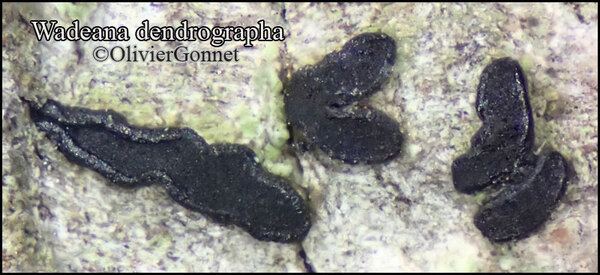
Courtesy Danièle et Olivier Gonnet - Source: https://www.afl-lichenologie.fr/Photos_AFL/Photos_AFL_W/Texte_W1/Wadeana_dendrographa.htm
France, oct. 2015 - sur Quercus ilex - Corse
Growth form: Crustose
Substrata: bark
Photobiont: Trentepohlia
Reproductive strategy: mainly sexual
Most common in areas with a humid-warm climate (e.g. most of Tyrrenian Italy)
Commonnes-rarity: (info)
Alpine belt: absent
Subalpine belt: absent
Oromediterranean belt: absent
Montane belt: absent
Submediterranean belt: extremely rare
Padanian area: absent
Humid submediterranean belt: extremely rare
Humid mediterranean belt: extremely rare
Dry mediterranean belt: absent

Predictive model

Courtesy Danièle et Olivier Gonnet - Source: https://www.afl-lichenologie.fr/Photos_AFL/Photos_AFL_W/Texte_W1/Wadeana_dendrographa.htm
France, oct. 2015 - sur Quercus ilex - Corse

 INDEX FUNGORUM
INDEX FUNGORUM
 GBIF
GBIF
